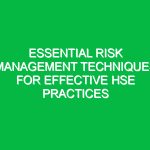In today’s world, the importance of health, safety, and environmental (HSE) management cannot be overstated. Organizations across various industries are increasingly recognizing the need to implement comprehensive risk control processes to mitigate potential Hazards that can affect workers, the community, and the Environment. This article delves into the essential risk control process, its relevance in the HSE domain, and how it can be effectively implemented to safeguard health, safety, and environmental Sustainability.
Understanding the Risk Control Process
The risk control process refers to a systematic approach organizations undertake to identify, assess, and mitigate risks associated with their operations. In the HSE context, this process is critical as it helps organizations create a safe working environment, protect employees from occupational Hazards, and minimize environmental impact. It encompasses various stages, including risk assessment, risk mitigation, monitoring, and continuous improvement.
Key Aspects of the Risk Control Process in HSE
1. Risk Identification
Risk identification is the first step in the risk control process. In this phase, organizations must systematically identify potential hazards that could lead to accidents or environmental damage. This can include physical hazards, chemical exposures, ergonomic issues, and environmental impacts.
A practical example of risk identification can be seen in the construction industry. During a site assessment, safety officers might identify hazards such as unguarded edges, electrical risks, or exposure to harmful substances. By recognizing these risks early, organizations can implement appropriate controls before work commences.
2. Risk Assessment
Once hazards have been identified, the next step is to assess the associated risks. This involves evaluating the likelihood of each hazard occurring and the potential severity of its consequences. Organizations often use qualitative and quantitative methods to assess risks, which helps in prioritizing which hazards need immediate attention.
For instance, in a manufacturing facility, a risk assessment might reveal that the risk of chemical spills is high due to the handling of volatile substances. The severity of potential exposure to employees and the environment could be catastrophic, prompting the organization to prioritize this risk in its Control Measures.
3. Risk Control Measures
After assessing risks, organizations must implement control measures to mitigate them. These measures can fall into several categories, often referred to as the “hierarchy of controls.” This hierarchy includes:
- Elimination: Removing the hazard entirely.
- Substitution: Replacing hazardous materials with less dangerous ones.
- Engineering Controls: Implementing physical changes to the workplace.
- Administrative Controls: Changing policies or Procedures to reduce risk.
- Personal Protective Equipment (PPE): Providing Safety Gear to workers.
For example, in a laboratory setting, if a specific chemical poses a significant risk to workers, the organization may choose to eliminate the use of that chemical altogether or replace it with a safer alternative. If elimination is not possible, engineering controls, such as fume hoods or Safety barriers, could be implemented to reduce exposure.
4. Monitoring and Review
Implementing control measures is only part of the process. Continuous monitoring and review of these measures are crucial to ensure their effectiveness. Organizations should regularly evaluate the performance of risk controls and make adjustments as needed. This could involve conducting audits, inspections, and employee feedback sessions.
A concrete example is a chemical processing plant that conducts quarterly Safety audits to assess compliance with established protocols. If deficiencies are found during these audits, the plant can take corrective actions to improve Safety Measures and reduce risks further.
5. Training and Communication
Training employees on risk control processes is vital for ensuring that everyone understands potential hazards and how to mitigate them. Organizations should foster a culture of safety by encouraging open communication about risks and safety practices. Regular Training sessions, workshops, and safety meetings can help keep safety at the forefront of employees’ minds.
For instance, a mining company might implement a rigorous training program for new employees that includes hands-on demonstrations of safety protocols and the use of PPE. This proactive approach helps ensure that workers are prepared to identify and respond to hazards effectively.
Benefits of an Effective Risk Control Process
Implementing an effective risk control process offers numerous Benefits, including:
- Reduced Incidents: A well-executed risk control process can lead to significantly fewer workplace accidents and environmental incidents.
- Improved Compliance: Adherence to legal and regulatory requirements is facilitated, minimizing the risk of fines and legal repercussions.
- Enhanced Reputation: Organizations that prioritize health, safety, and environmental protection often enjoy a better reputation among stakeholders, clients, and the community.
- Increased Productivity: A safe work environment contributes to higher employee morale and productivity, as workers feel secure and valued.
- Cost Savings: By preventing accidents and incidents, organizations can save on costs related to medical expenses, legal fees, and insurance premiums.
Regulations and Standards Governing the Risk Control Process
The risk control process is also influenced by various Regulations and standards that organizations must adhere to. These include:
- OSHA Standards: In the United States, the Occupational Safety and Health Administration (osha) sets forth regulations that require organizations to implement effective risk control measures.
- ISO 45001: This international standard outlines the requirements for an Occupational Health and safety management system, emphasizing the need for risk assessment and control.
- Environmental Protection Agency (EPA) Regulations: The EPA establishes standards for environmental protection that organizations must comply with, further influencing their risk control processes.
Compliance with these regulations not only ensures legal accountability but also encourages organizations to adopt Best Practices in risk management, ultimately leading to safer workplaces and reduced environmental impact.
Conclusion
The risk control process is a fundamental component of effective health, safety, and environmental management. By systematically identifying, assessing, and mitigating risks, organizations can create safer workplaces, protect the environment, and comply with regulatory requirements. The benefits of a robust risk control process are manifold, including reduced incidents, improved compliance, and enhanced organizational reputation.
As organizations continue to navigate the complexities of risk management, it is essential for them to foster a culture of safety and prioritize ongoing training, monitoring, and review of their risk control measures. By doing so, they not only protect their employees and the environment but also position themselves as leaders in the realm of health, safety, and environmental stewardship.


